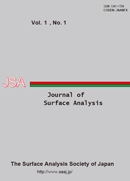Volume 14, Issue 1
Displaying 1-5 of 5 articles from this issue
- |<
- <
- 1
- >
- >|
Paper
-
2007 Volume 14 Issue 1 Pages 2-8
Published: 2007
Released on J-STAGE: October 20, 2018
Download PDF (586K) -
2007 Volume 14 Issue 1 Pages 9-19
Published: 2007
Released on J-STAGE: October 20, 2018
Download PDF (651K)
Serial Lecture
-
2007 Volume 14 Issue 1 Pages 20-48
Published: 2007
Released on J-STAGE: October 20, 2018
Download PDF (4049K) -
2007 Volume 14 Issue 1 Pages 49-58
Published: 2007
Released on J-STAGE: October 20, 2018
Download PDF (368K) -
2007 Volume 14 Issue 1 Pages 59-68
Published: 2007
Released on J-STAGE: October 20, 2018
Download PDF (1060K)
- |<
- <
- 1
- >
- >|
